Industry Status
The cost-driven model drives the development of technology, and the LED industry cannot do without this model. LED downstream applications continue to evolve, introducing light sources and lamps with higher wattage, smaller heat dissipation structure, and lower cost. These products have brought great difficulties in heat treatment, and also put more stringent reliability requirements on LED lamp beads, especially in anti-vulcanization, anti-oxidation and anti-bromination.
It is well known that LED brightness decay is caused by the blackening of the silver plating layer.
Blackening, which may be a vulcanization phenomenon, refers to a process in which a sulfur-(S) element in the environment is chemically reacted with a +1 valence silver to form a black Ag2 S under a certain temperature and humidity condition;
It may also be an oxidation phenomenon, which refers to a process in which oxygen (O) element in the environment is chemically reacted with +1 valence of silver to form black Ag 2 O under certain temperature and humidity conditions;
It may also be a bromination phenomenon, which refers to a process in which a bromine (Br) element in the environment is chemically reacted to form a light black AgBr under a certain temperature and humidity condition, wherein the -1 valence bromine reacts with the +1 valent silver.
Of course, other elements of Groups 6A and 7A are also likely to enter the interior of the LED lamp bead package to cause discoloration of the silver plating layer and reduce the brightness of the LED lamp bead.
How to solve the blackening problem?
Then, where the sulfur, oxygen, bromine and other substances enter the interior of the LED lamp bead package and react with the silver plating layer, understanding this entry channel is of decisive significance for us to solve the blackening problem.
Whether the various channels can effectively block is the key to our problem solving.
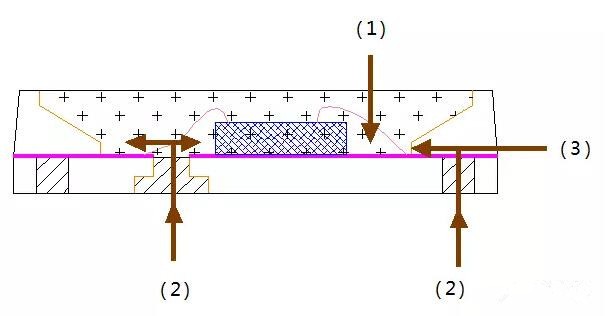
figure 1
Silicone and silicone resins (collectively referred to herein as silica gel) are commonly used as encapsulants for LED lamp beads, which have a certain moisture permeability and oxygen permeability, especially in high temperature environments, such as sulfur, oxygen, bromine and the like. Pass through the silica gel and enter the inside of the LED lamp bead package.
1. Method 1 adopted by the industry: hard silicone package
At present, most LED packaging plants use higher hardness silica gel as the packaging material of LED lamp beads to delay the blackening time, but the stress problem caused by the higher hardness silica gel increases the reliability of the internal structure of the LED lamp bead package. Sexual risk. In the case of thermal expansion and contraction, the bonding wires inside the LED lamp bead are easily broken to cause functional failure. However, even with a silica gel of higher hardness, the glass transition temperature of silica gel is only 50-70 ° C. At high temperatures, the molecular structure of the silica gel becomes larger, and sulfur, oxygen, bromine and the like are also easily accessible to the LED. The inside of the package reacts with the silver plating layer.

figure 2
2, the industry adopted method 2: silicone surface coating organic gas barrier material
Therefore, many LED packaging factories still use a softer silica gel, and a layer of organic gas barrier material is coated on the surface of the LED lamp bead package to avoid the stress problem of the high hardness silica gel while delaying the blackening time.

image 3
It is not difficult to see that the higher hardness of the encapsulant or the surface coating of the organic gas barrier material, the two methods to solve the blackening problem are only improved in the front channel of the colloid (1), the other channels are still not blocked, sulfur The oxygen, bromine and other substances easily enter the inside of the LED lamp bead package, and the two methods are very ineffective. Moreover, it is coated on the surface of the LED lamp bead, and the organic gas barrier layer is easily worn in the later processing. At the same time, the organic gas barrier material is easily degraded in a high temperature environment for a long time, and undergoes molecular fission and cracking, and ultimately does not provide effective protection.
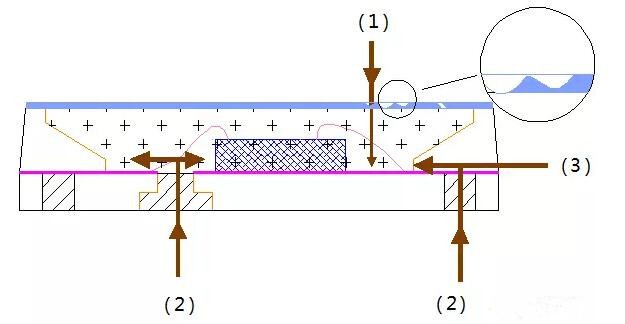
Figure 4
3. Method 3 adopted by the industry: coating the organic gas barrier material with silver plating layer
Due to the chip-type LED structure, the barriers of (2) and (3) channels are quite difficult, which is also the technical bottleneck of the current LED packaging industry. Blocking the channel is difficult and difficult to solve. To solve the blackening problem effectively, it can only be completely protected on the surface of the silver plating layer. Some LED packaging factories apply organic gas barrier materials on the surface of the silver plating layer. Even if the channels are not blocked, sulfur, oxygen, bromine and other substances enter the LED package and cannot react with the silver plating layer.
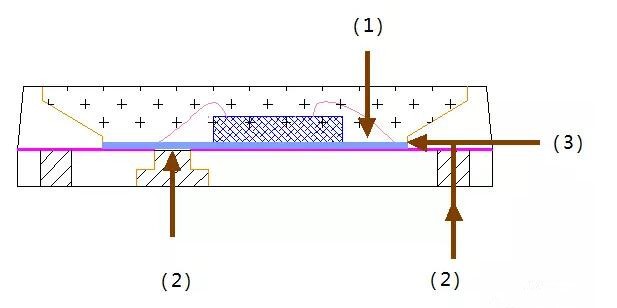
Figure 5
However, the thickness and consistency of the organic gas barrier material are difficult to control. It is important that the organic material is easily degraded in a high temperature environment for a long time, molecular fission occurs, and the organic gas barrier layer is cracked, and finally the protection is not good. .
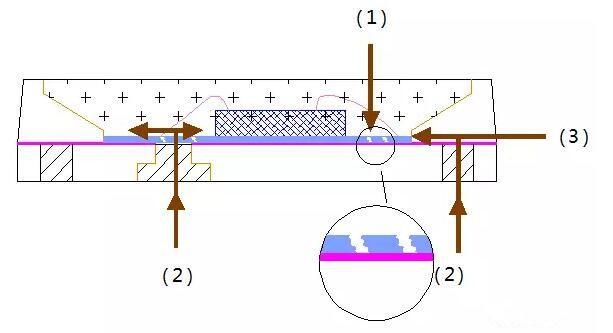
Figure 6
Semiconductor's solution
Smecta Semiconductor Co., Ltd., a wholly-owned subsidiary of Hongli Zhihui Group, adopts advanced, cutting-edge and unique PPL technology to solve the blackening problem, depositing a layer of inorganic substances on the surface of the silver plating layer, which has excellent compactness. It effectively blocks the reaction of sulfur, oxygen, bromine and other substances with the silver plating layer. At the same time, it has long-lasting and stable chemical properties, and has outstanding performance in corrosion resistance and high temperature resistance, completely solving the blackening problem caused by vulcanization, oxidation and bromination. The product produced by the company's PPL technology has a 40% higher vulcanization test at 110 ° C than the normal product.
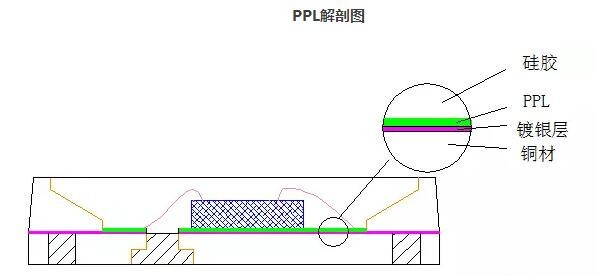
Comparison of anti-sulfurization effects of different anti-vulcanization methods:

High temperature aging experiment comparison:

High temperature aging, comparison before and after vulcanization
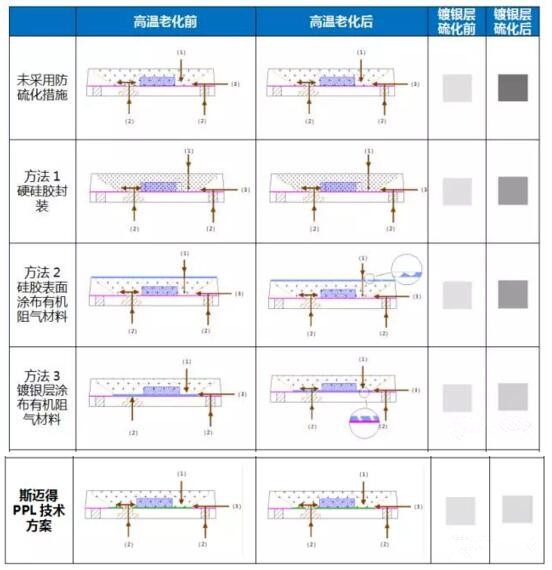
PPL technique, reassign the LED characteristics of a long life lamp beads, binding PPA, PCT holder carrier encapsulated by injection molding in the LED lamp can be achieved in most applications the life (L70) of 50,000 hours, PPL technique Will shine in more demanding applications.
In January 2017, Smtech Semiconductor's PPL non-vulcanization product solution achieved its first mass production in China. The PPL non-vulcanization process solution can cover a full range of SMD, SMC, and EMC products, and can completely solve the problem of vulcanization. Up to now, it has applied for 3 invention patents.
In addition, EMC3030/5050/7070 products are used more widely. In outdoor lighting, especially EMC5050 products, light efficiency 240LM/W can be achieved in 1W, combined with PPL anti-sulfur technology, SMC package, higher reliability, SMC5050/7070 products will gain a rapid growth in outdoor product applications. . At the same time, it will be widely used in high-power products, automotive lighting and other fields.
Eelctrical Pvc Accessories,Cable Accessories Fittings,Electrical Pvc Cable Trunking Fittings,Electrical Wire Cable Trunking Accessories
FOSHAN SHUNDE LANGLI HARDWARE ELECTRICAL CO.LTD , https://www.langliplastic.com